Train Order Boards and Train Operations.
Train Order Boards and Train Operations.
|
OK Guys, let me try to make the mystery of the Train Order Boards simpler for you. Here is the way that it Used to work before the rules were changed in the 1990's.
Imagine that the DSP&P (or any railroad for that matter) is a giant train layout. At the end points, say, Denver, Central City, Baldwin, Buena Vista (it was on a branch). The trains originate or Terminate (hence, Terminals). In between you have blocks, like the old DC blocks that you used to set up for your HO layout. Trains originate in Denver. Crews get on the trains at either 7th Street or at Rice Yard. The crews are called, register in, get their Clearance form C and their train orders. They move their train through the Yard Limits (Train Orders not needed) to the main line. Once on the main line they are governed by the Train Orders that they possess. These will tell you the trains that you will meet, where, who will hold the main line, who will clear up on the siding or passing track. They will also inform you of track conditions, whether maintenance of way is working or not and where. Otherwise the trains superiority is determined (in this order) by Right, Class and Direction. Right is determined by Train Order. Class and Direction are determined by TimeTable. Did you ever look at an old timetable and see the times listed in BOLD numbers? Those are scheduled meeting points between two trains listed there. Extra Trains, because they are Extra to the timetable, are not listed. The train clears the Yard Limits and moves from Denver (Block A) to Sheridan Junction (Block B) At Sheridan the Train Order Signal is clear. BUT Sheridan Junction is a register station because the track splits. So the Engineer AND Conductor Register and sign in the book with train Number (or symbol), Locomotive number, time and direction. They whistle by the station and go on to Bailey's (Block C). At Bailey's, the Train Order Signal is red. Just like a Red Light at an Intersection, you stop before you pass it. Since the depot is occupied, there will probably be orders in the hoop that the Agent is waiting to give you if they are Form 19 orders. If they are Form 31 Orders, the engineer and conductor must sign for them. This could be anything from a new slow order to informing you of the fact that Maintance of Way has cleared up and the order that you have in your posession concerning that is annulled. To make this easy for you, you are on a scheduled Freight Train, Since you are scheduled, your train is superior to any extra (non scheduled) trains but inferior to Eastbounds (remember Direction) and Passenger Trains (Class). Let's say that the next manned Station is South Platte (Block D). This would mean that all of the signals from Bailey's to South Platte should be set to "Clear". During the height of traffic, signals would probably be closer, but this is an example. At Bailey's you sit for what seems like a long time, but you are running on the clock, but waiting for a Work Extra to clear up ahead of you. The Agent will clear you when he hears from the Dispatcher that the work extra is in the clear. So you get a clear, you check the signals at South Platte for anything coming off of the NightHawk Branch. Nothing? So you travel on to Jefferson (Block E). At Jefferson you see that the block is also red, so you stop your train, cussing the dispatcher every second because you have to use more air than you wanted too to stop. It seems that the Passenger Train that you are following is having a bit of trouble with too many cars and not enough horsepower. He has only left Jefferson five minutes ago, instead of the 15 minutes on the time card (Yes, timetables were called time cards). So the agent at Jefferson, acting very much like ABS or CTC would in the future, holds you until 10 minutes has passed. Your signal is rotated to clear. You check your train orders again and see that you are to take siding at Michigan. This is to wait for an eastbound time freight out of Como. You begin cussing under your breath because you know that the freight won't be released out of Como until the Passenger Train arrives. So you take your time and clear up in the siding at Michigan. At 540', you barely fit. So you, as Engineer, Oil around, check the brake rigging and lubrication on the locomotive, Put the seat up and wait. After the time freight that you have been waiting for passes, you start out for Como once again. You check the board at Como (end of Block "F") and pull your train up to the end of the passing track there, knowing that the outbound crew will be waiting to take the train on or you will be ordered to tie your train down until the outbound crew is rested and ready. So this is what the Train Order Boards are used for. They are used like block signals to space trains, they are used to stop trains to convey information to the crews. Since trains will originate at various points where the track goes no further, the need for a train order board is unnecessary. That is why you will not find one in Denver, or Central City, or Baldwin or Bakerville and later Silver Plume. Jim Courtney, I can attest to the hardware for the Swift Signal being in the Silver Plume Depot. I do not know how often it was used after the 1898 abandonment of the line to Bakerville. You will find one at Black Hawk, Idaho Springs and all of those intermediate stations that Chris and Jim have found. Remember, even though Black Hawk had the yard, it was an on line station and Intermediate to the traffic going up the Switch Back. Also, the question begs to be asked, why so many train order boards? Remember, as the Railroad was built, they were expecting huge amounts of business from the various mining areas and probably felt that these stations were necessary to control the flood of traffic coming from them. Their Crystal Balls were as cloudy back then as ours are today. They also did not have the benefit of 20/20 hindsight. I would bet dollars to doughnuts that at one time Dome Rock had a train order signal as well. The photo that I have seen of the front side shows the depot with a white picket fence. This fence was placed there after the railroad had decomissioned the depot and started renting it as a private residence. Rick |
|
Thanks, could you expand a bit more on what would happen in Como and how the TOB would be used.
Want to make sure I am telling people the right thing. |
Re: Train Order Boards and Train Operations.
|
In reply to this post by Rick Steele
Rick,
Thank you. Your comparison to a model railroad with blocks was very helpful. I will re-read it several times to completely appreciate the operation and implications of TO boards and operation. Lee Gustafson |
Re: Train Order Boards and Train Operations.
|
This post was updated on .
In reply to this post by Rick Steele
Rick,
An excellent description of what it was like to railroad during the era of Time Table and Train Order operations, before CTC and radio communications. I thought I might further illustrate all the points you make with some actual train orders. DISCLAIMER: What follows has nothing to do with the C&S or another Colorado narrow gauge road. But the documents below were typical of the "flimsy" orders that governed most all railroad operations. If the reader finds it uninteresting, feel free to skip it. Every summer from 1969 to 1973, I worked as a brakeman for the Rock Island out of Ft Worth, Texas, to pay my way through college. The last CRI&P train I worked was a south bound grain extra, on June 30, 1973. I kept my full set of train orders for that day as a memento of my brief railroading career. On June 29th, I had worked my last northbound freight from Ft Worth to the next division point at Waurika, OK. When the crew tied up, we all used the station agent's car to drive up to the diner on the main highway. We probably dined on chicken fried steak with pasty white gravy and fries. We laid over the night of the 29th-30th at the little railroad hotel next to the depot, kinda like a Motel 6 of the day, but not as nice. Late on the morning of June 30th, the crew "call-boy" (actually a fairly old guy, with missing teeth) notified us to be at the depot at 1:00 PM to take a southbound extra back to Texas. Our train, Extra 246 South would follow another grain extra, Extra 358 South. Both trains were 80-100 cars of solid covered hoppers, loaded with export grain, destined for the port of Houston. A lot of grain was being sold to the USSR in the early 1970s. When we arrived at the depot, the agent handed each of the 4 members of our train crew a stapled set of orders and train clearance: Train Clearance Form, stapled on top: 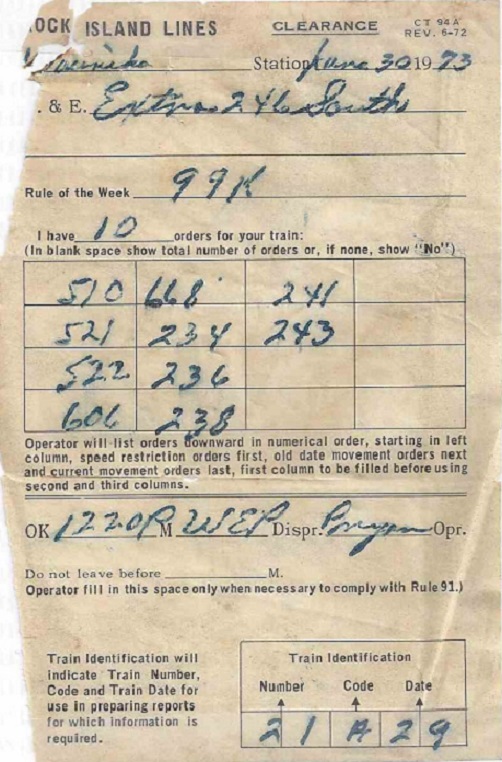 This little white slip of paper authorized our train to depart the division point at Waurika, and listed all the attached orders, by number, that would govern our journey back home. Order creating the extra train with its (their) designations: 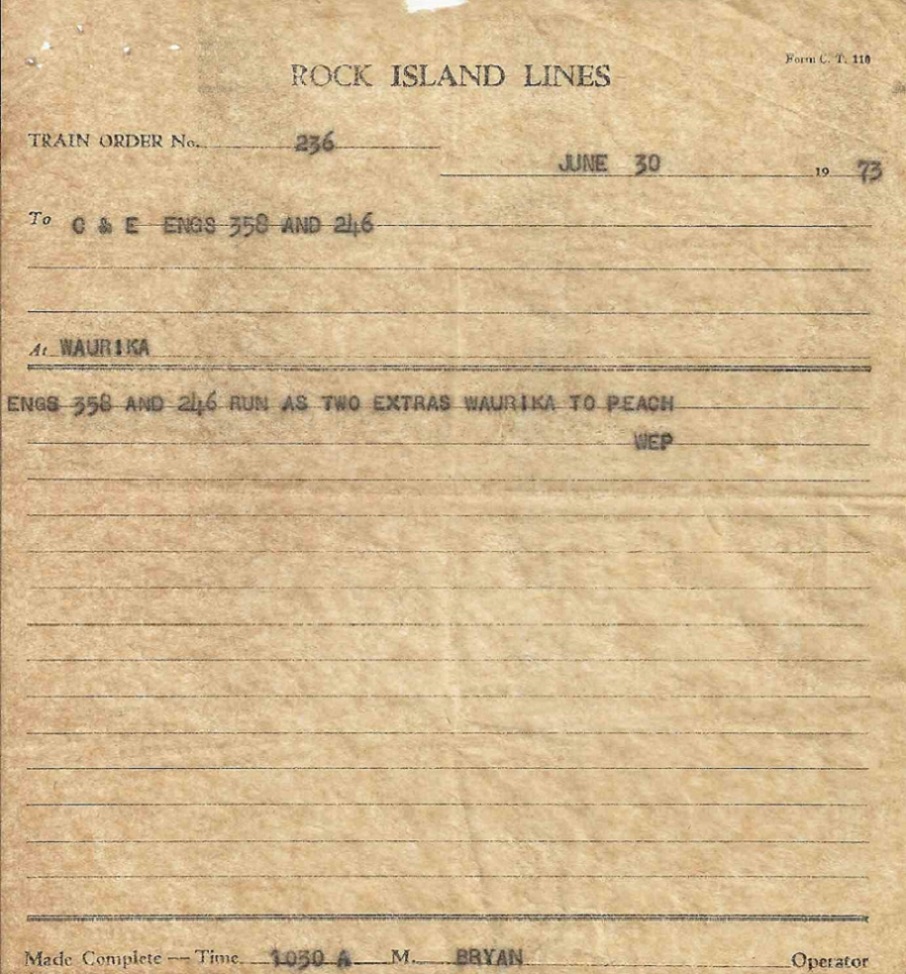 Each train on the Rock Island main usually had 3 to 4 units on the head end. Lead engine 358 on the first extra South was a fairly new GP-40. Our lead unit, 246, was a four-axle GE Uboat. "Peach" referred to the CRI&P Peach Street Yard in Ft. Worth, TX. Order of rights by direction, with conditional wait orders:  Orders for specific meets with other trains: 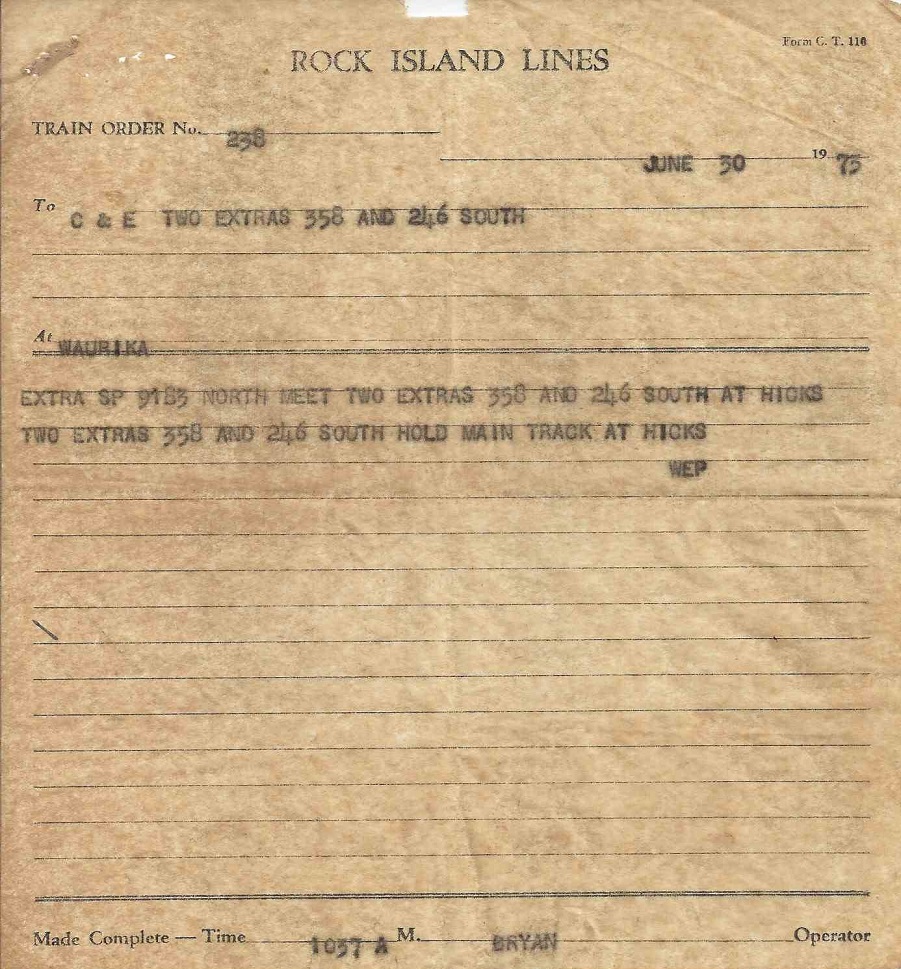 An extra north, lead by leased SP unit 9183, would have to wait in the siding at Hicks, forever if necessary, until both the south bound extras passed.  Extra 1210 North was a local freight, the "Chico Turn", handling the crushed limestone rock business at Chico (destined to make the concrete for the runways at the new D-FW airport, then a-building). The Chico turn had arrived and was busy switching the rock crushers long before our Extra 246 south arrived at Chico. Speed restriction orders--mainline, sidings, temporary: 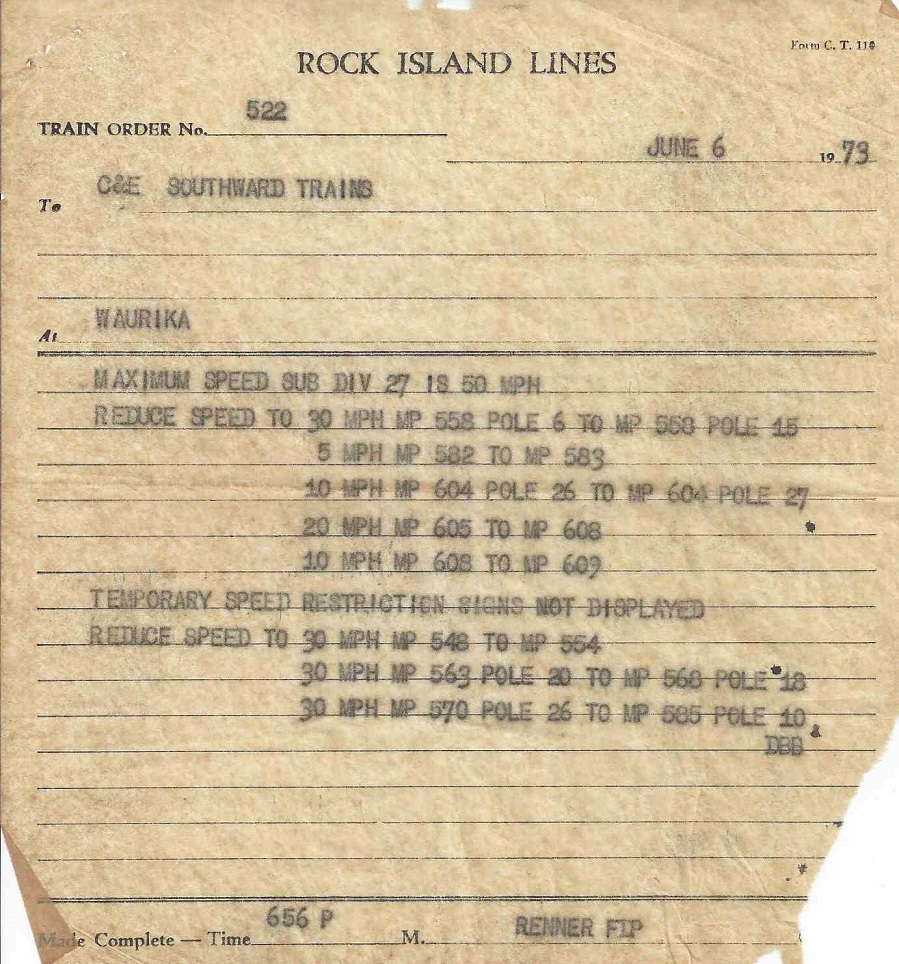 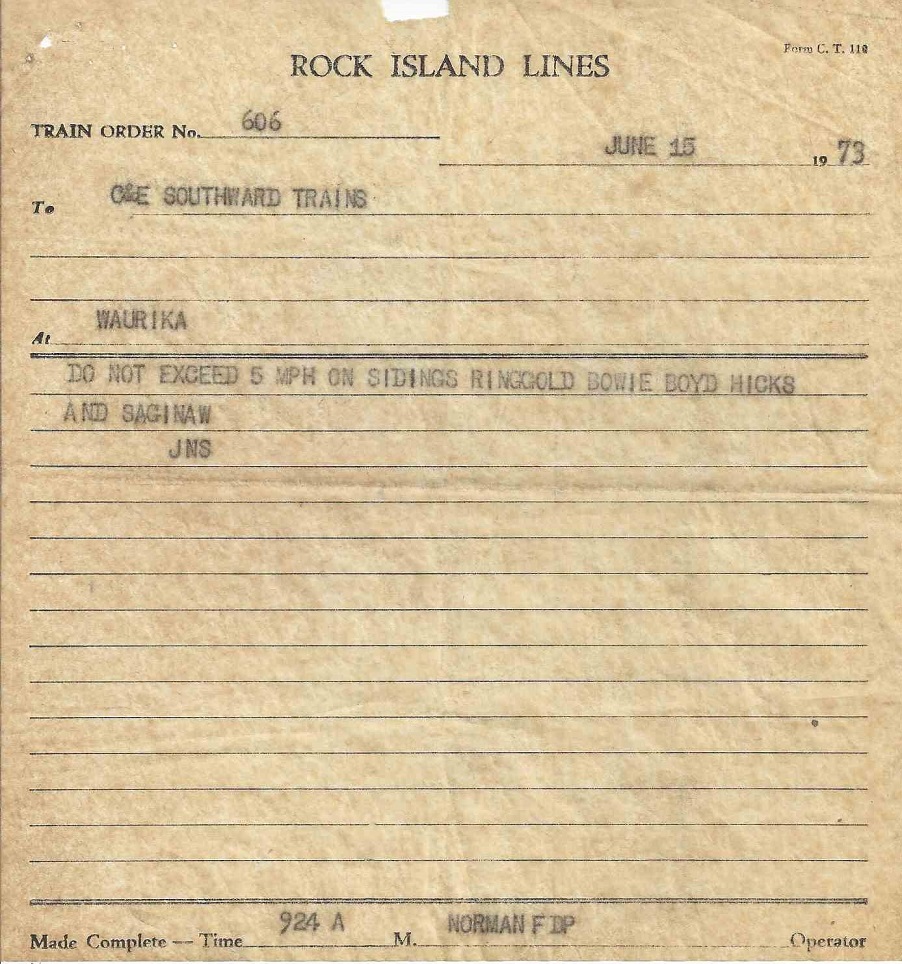 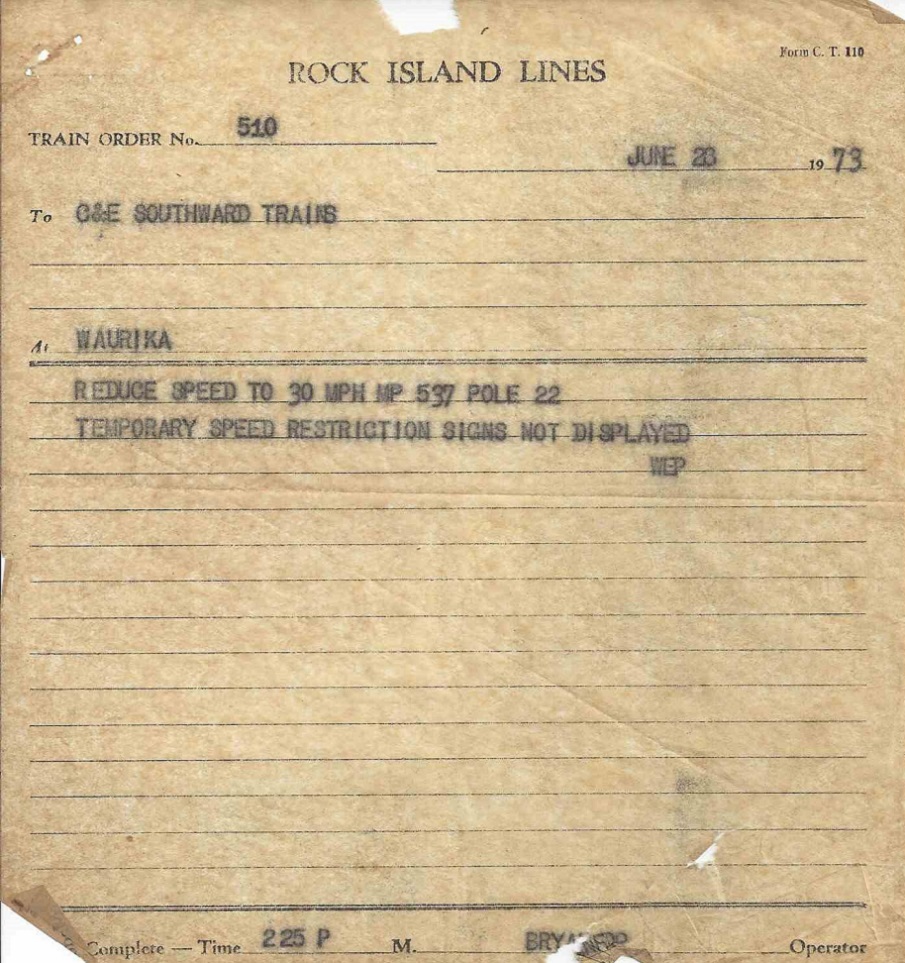 Track restriction orders:   The Rock Island was nearing its famous bankruptcy and a lot of track was in poor repair. Having looked over our orders and having watched Extra 358 South change crews and depart, Extra 246 South finally arrived. The El Reno, OK, based crew de-trained, our crew climbed aboard (I was working as head-end brakeman as I recall) and we departed for Texas. At some point, probably as we were were crossing the Red River bridge, the Dispatcher decided to reschedule a meet between our train and a north bound extra, sending the orders to the operator at Chico. A new Clearance form was required for our train to depart Chico: 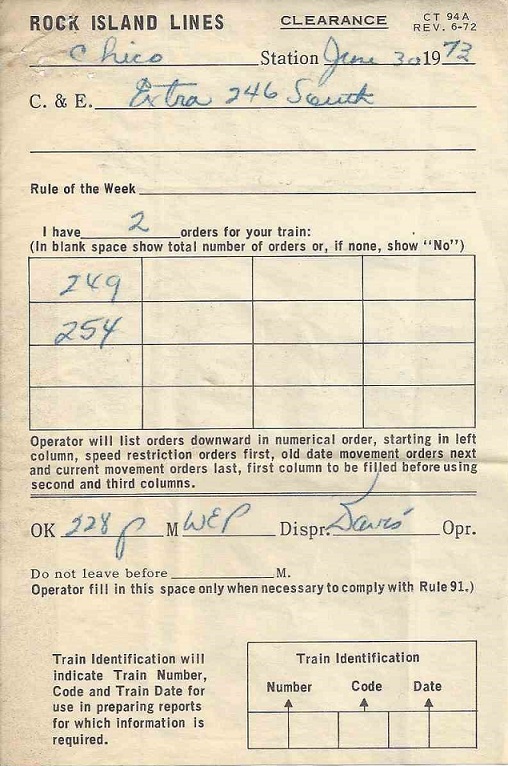  But an hour later, the Dispatcher changed his mind, issuing new orders for our train at Chico: 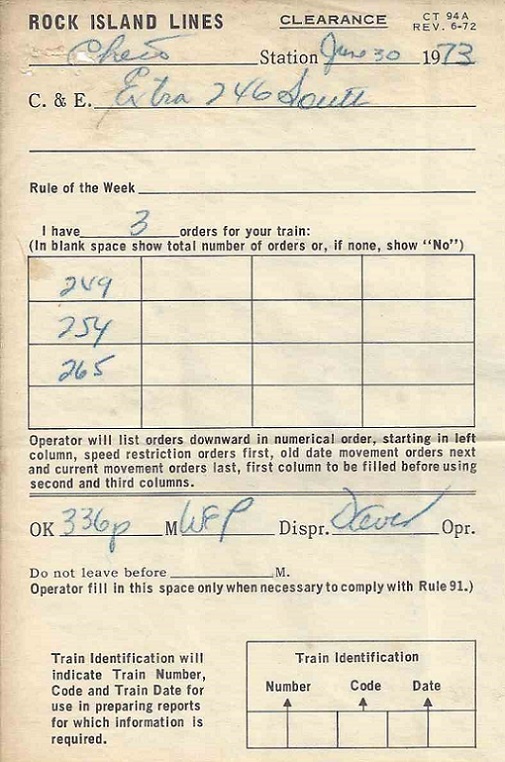 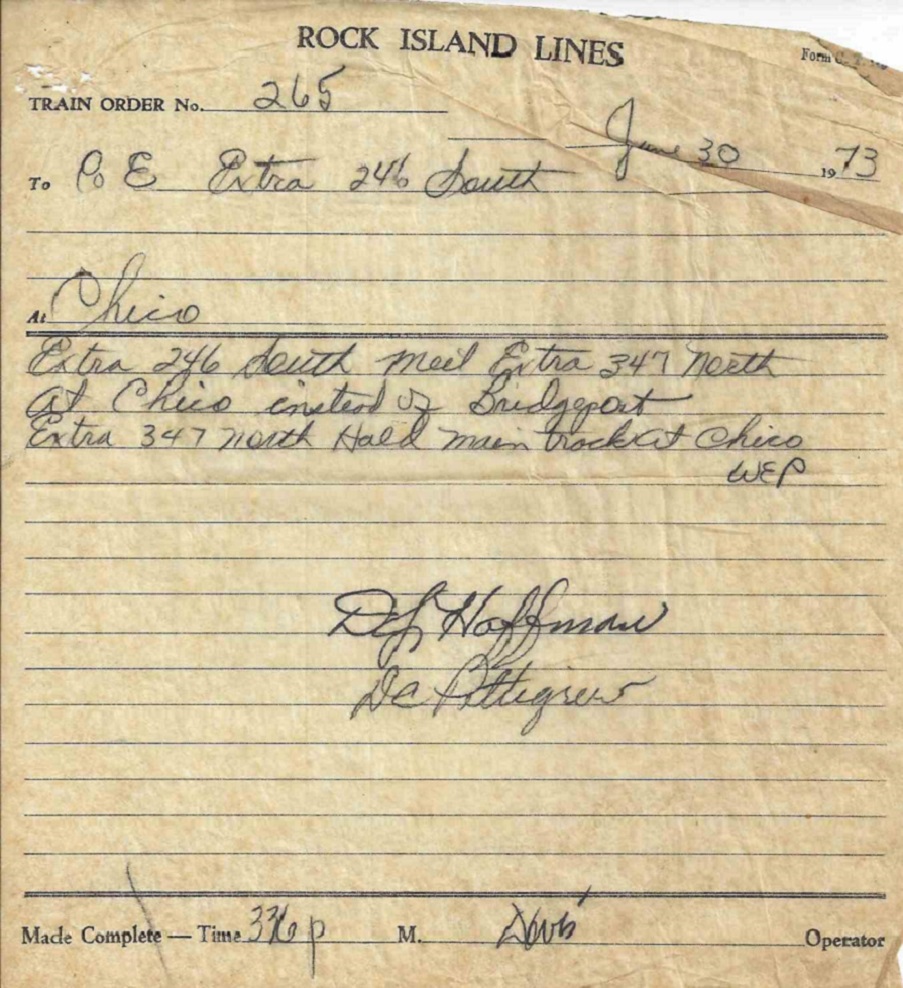 So as Extra 246 South approached the little train order station at the north end of Chico siding, from the engine we saw the order board set to red, and a bit further down the line, the ABS signal guarding the entrance to Chico siding displayed "Absolute Stop". As we had lost the right for our train to hold the main, I likely climbed down from the lead unit, walked to the north siding switch-stand, unlocked it and then aligned the points for the siding. I caught the lead unit as the train entered the siding. When "in the clear" the rear brakeman re-aligned the north siding switch to the main . . . and we waited. When Extra 347 North finally approached, I likely climbed down and crossed over to the other side of the main to inspect the northbound train as it rolled by. I would have then walked up to the south Chico siding switch-stand, lined us for the main, and after a while we were on our way south again. We eventually passed extra SP 9183 at Hicks, releasing it from siding Purgatory. When we arrived at Peach Yard, I would have cut the power off the train once stopped in the receiving track, and lined yard switches to get the power back to the "round house", no longer round. Tying up at the Yardmasters office, it was a short walk to my car, then home for a good night sleep. The following week I was laid off as a brakeman, but was able to work a few weeks as a Switchman, off their extra board. Then so ended my railroading days, and I was off to Houston to start Medical School.
Jim Courtney
Poulsbo, WA |
Re: Train Order Boards and Train Operations.
|
In reply to this post by Rick Steele
CONTENTS DELETED
The author has deleted this message.
|
Re: Train Order Boards and Train Operations.
|
John,
That's an excellent question! Given all the flag stops in Platte Canon, did just any C&S passenger train stop, including the Denver-Leadville passenger? The Fish trains supposedly stopped anywhere, picking up fishermen along the right of way, even between stations. And the "down" morning passenger train from Silver Plume to Denver and return--did it make flag stops as well, as it was the designated Clear Creek "local."
Jim Courtney
Poulsbo, WA |
Re: Train Order Boards and Train Operations.
|
In reply to this post by John Schapekahm
You will notice that the Depot shown is Fort Logan.
This photo was taken before the UP Bankruptcy in 1893. How do I know? Simple. The sign out front advertises Pacific Express Company. This company disappeared before the 1893 Bankruptcy of UP. OK, that being said, the Valuation Field Notes show no Swift Train Order signal at this depot and a careful perusal of the photo shows no holes drilled in the building to accommodate the train order signal. The way that a flag stop used to work was like this: The flag stops were designated in the employees timetable. When approaching these stops the Engineer would Sound the whistle, either by rules or for the "S" sign usually placed one mile from the station to warn potential passengers of the train's arrival. The engineer would observe to see whether or not a red flag was placed (usually) in a flag holder outside the depot. Observing the rules, he would stop before any part of the train or Locomotive passed this flag. Either the Engineer or Conductor would ascertain from the individuals on the platform whether or not they placed the flag. If the individuals on the platform placed the flag, the flag would be removed, the passengers boarded on the train and a cash fare and ticket issued to them by the Conductor. The train would then proceed to the next station. If the flag was not placed by the waiting passengers, then it was up to the conductor to communicate with the dispatcher and find out why the flag had been placed and by whom. Oh some railroads, flags were dispensed with and the passengers would wave a handkerchief or something visible to the engineer, at the train indicating that they were waiting to board the train and, from Fort Logan, Make the trip to Denver or to Morrison. On some railroads, all passenger trains had to respect the flag stops, on others, these flags only had to be respected by local passenger trains while express passenger trains were allowed to proceed. But being on the 3' gauge, even the San Juan "Express" would respect flag stops. Rick |
Re: Train Order Boards and Train Operations.
|
In reply to this post by ComoDepot
The Train Order Board outside of Como Depot would probably be permanently set to Red.
The Rules read that for a Red (or stop) signal that a train has to stop before any part of the train or engine passes the signal. I am sure that it was set this way in Como because it was a Crew Change point as well as the location of the Dispatcher's Office (at one point) and, for the C&S narrow gauge, a major terminal. After the Crew was called and put on the train, and the Clearance Card and Train orders received, The signal would be turned to "Clear" to indicate that a particular train could leave for either Leadville or Denver. Pre-1908, the train could also continue to Gunnison. It is a signal, and at night the lantern on top would display the green to the clear paddle (the white one) and Red to the Red paddle. The Swift board served, in Como, to space trains and depart trains after making sure that the crew had their Clearance form C and their Train Orders. Rick |
Re: Train Order Boards and Train Operations.
|
In reply to this post by John Schapekahm
John:
Looks like the flag in question  is in the ladies right hand. is in the ladies right hand.
Shall I craft a hankie in Sketch Up and send it to Shapeways for a print?
Keith Hayes
Leadville in Sn3 |
Re: Train Order Boards and Train Operations.
|
In reply to this post by Rick Steele
Rick,
That explanation of the purpose of the TOB at Como finally makes sense to me! Perhaps, that was the purpose of the TOB at Silver Plume as well. The excursions and regular passenger up the Loop to the Pavilion wye often ran in multiple sections. The TOP at the Silver Plume depot could well have been used to clear each section of the trains, as they returned eastbound to Denver, spacing them out as you suggest.
Jim Courtney
Poulsbo, WA |
Re: Train Order Boards and Train Operations.
|
This post was updated on .
In reply to this post by Keith Hayes
The gentleman with the bike has his "flag" in his jacket pocket, in case the lady's flag fails to stop the train.

Jim Courtney
Poulsbo, WA |
|
In reply to this post by Rick Steele
May have mentioned this on another thread, annoyingly I can not remember who told me this but I was told it was originally set to red and later to green.
|
Re: Train Order Boards and Train Operations.
|
Yes, I read that. I would doubt that it was "Permanent" but I am sure that it was the default for the signal set by either the Dispatcher or the Agent to make sure that all departing trains had their proper paperwork.
The Red was probably set after too many through trains just ran the signal without receiving the paperwork needed. So let's go to the Operating Rules, shall we? under the heading TRAIN ORDER SIGNALS Rule 200 (A) shows the drawing of a swift type of signal set to the Stop Position: Name---- Stop Signal. Indication ----- Stop for orders or receive clearance. Also, regarding the "flag" in the lady's hand in the Fort Logan Photo, under the heading HAND, FLAG AND LANTERN SIGNALS Rule 12 (h): Any object waved violently by any person on or near the track must be respected as a signal to stop I don't know how violent the woman on the platform could be, but waving her hankie would probably count at a flag stop. Rick |
Re: Train Order Boards and Train Operations.
|
Maybe she should do like Claudette Colbert did in "It Happened One Night"-show some leg.
|
Re: Train Order Boards and Train Operations.
|
I guess that would all depend on whether she wanted a cab ride or not....
|
Re: Train Order Boards and Train Operations.
He he... in Ireland when you stop to pick up a hitch-hiker you have to ask them if they want a "lift", because a "ride" means something different altogether.... Cheers, Jeff. |
Re: Train Order Boards and Train Operations.
|
Read without further elaboration....
|
Re: Train Order Boards and Train Operations.
|
Thank you Rick, I didn't have the time to go search out your old Gazette articles and I can't have any feel for this subject since I never operated under Train Orders.
We only had one line here in the North Island, that I knew of, that was worked as "Open Section", i.e. trains operated strictly in accordance with Timetables and Train Advices, that could be similar, but that line was out of my operating district. I was used to Tablet Working (aka Token, and Staff systems were similar too), CTC, and Double Line Automatics but also had to know, sit exams and be certified in operation of Open Section and Single Line Automatics as well. Later when the Tablet System was dismantled in the early 1990's, we went to Track Warrant which I figure be as close to TO's on those lines not controlled by Automatics or CTC. Under Tablet working we always were required to be in possession of a Tablet to be in the Section between Stations, in the early day's the yards were controlled by a Signal Box (Tower) at either end and the Signalman was the one to give permission to depart, after having been instructed by the Train Controller. At smaller Stations, the Tablet Operator would be in the station building with a Lever Frame outside to operate the Home signals and maybe a Starting signal otherwise out came the Green Flags. If there were Colour light signals then there was a small mini Track Diagram panel inside. Stations in tablet sections were still 70% semaphores to the end but there were some with Colour Light signals. Most of those were then converted to Switch Indicators for Track Warrant operation. If the train was to pass through on instructions from Train Control, then the Signal would be pulled Off, ie set to Clear and a "Right-of-Way" signal given for the train to procede through. Provision was made to exchange Tablets by hand or automatically with the use of the most wicked looking Tablet Exchanger device that was set up on the Station platform and also on the side of the Locomotive cab. The Tablet Machines were electrically interlocked and needed a code of Bell signals to be worked in conjunction with the operator at the other end of the section, this prevented more than one Tablet being removed at any time for the section. As what I've just related about the Tablet system is probably alien to most of you, here's a demonstration of the working of retired machines, as these are alongside each other not seperated by a few miles. https://www.youtube.com/watch?v=WlXoHqm5S9A I guess most of you will also need a translator... So you might understand the difficulty I had understanding Train Order operation in such discussions. Not anymore, thanks to Rick and Jim's excellent work above.
UpSideDownC
in New Zealand |
«
Return to C&Sng Discussion Forum
|
1 view|%1 views
| Free forum by Nabble | Edit this page |

